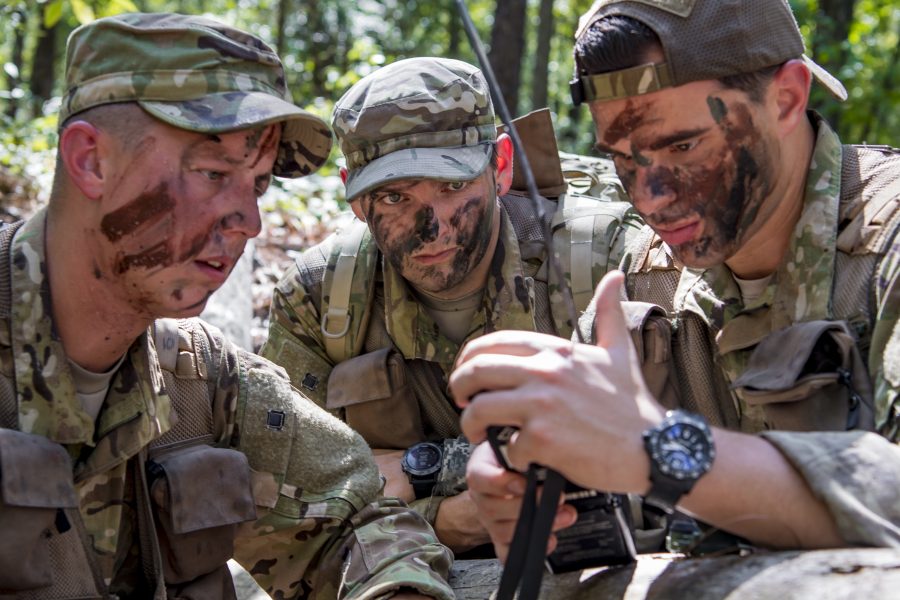USAF may soon update its initial Survival, Evasion, Resistance, and Escape training to better suit the demands of different Air Force Specialty Codes. The new program will incorporate preliminary distance learning so students can hit the ground running once they arrive at Fairchild Air Force Base, Wash., the head of the 336th Training Group told Air Force Magazine.
The course currently puts all participants through the same approximately 26-day training, which includes combat- and water-survival courses, said Group Commander Col. Carlos Brown. This constitutes what he calls “the platinum standard of level-C code of conduct survival training.”
But giving every Airman who comes through the Fairchild schoolhouse the elite treatment isn’t logical, Brown said, since those working in combat-support-centric AFSCs might not face the same likelihood of being captured by an enemy as Airmen who “go beyond … the forward line of troops in battle.”
“It just didn’t make sense that, for example, a flight attendant on … say Air Force One, you know what are the chances of that individual finding themselves … in enemy hands? It’s probably relatively small versus … an F-16 or F-22 pilot, or an H-60 combat rescue pilot, or crew members finding themselves in harm’s way on the battlefield,” he explained. “So it just made sense that we kind of take a look at this and get the right person the right level of training.”
Under a proposed modernization plan currently under review by USAF leadership, initial SERE training will come in three proverbial flavors, each tailored to a particular AFSC’s vulnerability to capture, he explained.
Airmen whose jobs make them the easy targets will train for about 19 days, those facing a medium risk of capture will train for approximately 12 days. Finally, those at the lowest risk of getting kidnapped will take “a condensed course” that will last “about five days,” he said. Brown said this course will essentially be an expanded version of the Evasion and Conduct After Capture course that’s currently administered at the 336th TRG’s Detachment Three at Joint Base San Antonio-Lackland, Texas, and he envisions it will be initially run at Lackland.
Since shorter course periods won’t require as many instructor cadres, Brown explained, the change will let the 336th TRG move SERE specialists where they’re most needed.
“We could potentially push the SERE specialists to these high-demand units that right now might be unfilled,” he said.
The remix will also save money, he said, by freeing up “seven days of people’s time” and reducing the group’s reliance on contractors “to gap needs,” Brown said.
The modernized course also will incorporate distance learning, Brown said.
When the 92nd Air Refueling Wing commander recently implemented a 14-day Restriction of Movement at Fairchild due to COVID-19, 336th TRG leaders went to work making sure SERE trainees-to-be weren’t stuck twiddling their thumbs before the course formally kicked off.
“We captured all of the platform instruction that we would normally do for most of the course and real rapidly put that into about 25 hours of a correspondence course,” Brown said.
The group then created its own in-house “DVDs, hard-copy lesson plans, and workbooks,” and handed them out to students. After the Airmen had 2-3 days to review the material, the group hosted teleconferences where they could pick leadership instructors’ brains about areas of confusion or workbook inconsistencies (“for example, there could have been 10 answers to a question, but there was only five spaces”), Brown explained. This both helped the students better comprehend the course material and helped group leadership “baseline … any technical corrections,” he said.
The first class to use distance learning graduated May 1, but the group has used this approach with every incoming class since April 13. The next goal is to get the distance-learning coursework uploaded “onto a collaborative platform like either Blackboard, Joint Knowledge Online, [or] ADLS [USAF’s Advanced Distributed Learning Service]” so Airmen can complete that portion of the coursework at their home station before they get to Fairchild, Brown explained.
Prior to the virus’ arrival on American shores, the only time distance learning was used in the context of SERE was in a Level A introductory, familiarization-style course that individuals going through Basic Military Training or Airmen attending Officer Training School took in the form of Computer-Based Training.
“After that, all of the training—to include academics—was done here at Fairchild,” Brown explained.
According to Brown, a revamp of USAF’s initial SERE training “has been a topic of discussion for well over a year” and he asked the Air Staff’s Special Warfare Division about getting a modernization plan in motion last December.
Rather than becoming sidelined by the coronavirus crisis, he said, the pandemic actually allowed his team to pivot away from busy work and focus on the proposed training remix. According to Brown, the 336th TRG, the Air Staff’s Special Warfare Division, and Nineteenth Air Force talk daily, and “everybody’s kind of working in unison towards this” so they can bring it to Air Force operations chief Lt. Gen. Mark Kelly.
“We don’t have a lot of distractions and now we can go after the most important mission focus,” he said.
While the modernization plan is still technically pending approval from Air Force leadership, Brown expects the decision to come down by this summer.
“It’s not really, in my opinion, a decision of for or against,” he said. “It’s just making sure we educate every major command on the level of training that their personnel receive so it doesn’t sound like they’re not going to get an adequate level of training.”
Editor’s Note: This story was updated on May 6 at 10:39 p.m. EDT to correct which Numbered Air Force the 336th TRG was communicating with on the modernization plan and which Lt. Gen. Kelly the plan would be presented to.


